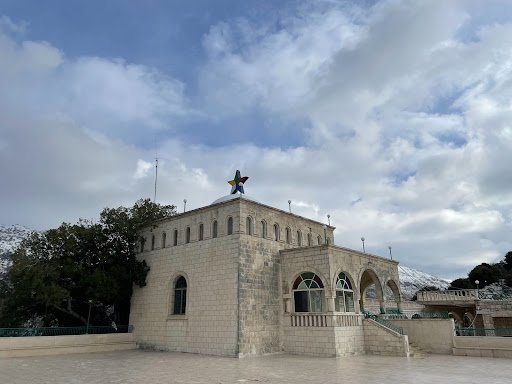The Druze religion originated in the 11th century in the Middle East, specifically in the region of the Levant, which includes parts of present-day Lebanon, Syria, Israel (Palestinian Territory), and Jordan. The Druze community emerged as a distinct religious group with the teachings of Al-Hakim bi-Amr Allah, the sixth Fatimid Caliph of Egypt, who is considered a central figure in Druze theology. The Druze faith is an offshoot of Isma’ilism, a branch of Shia Islam, but it has evolved into a unique and independent religious tradition with its own distinctive beliefs, practices, and rituals.

Druze Shrine – Credits from https://www.alfusaic.net
The Druze community has historically been concentrated in the mountainous areas of Lebanon, particularly the Chouf region, as well as parts of Syria, Israel (Palestinian Territory), and Jordan. Druze religious centers, such as the Maqam al-Nabi Ayoub (Job) shrine in Lebanon, play a significant role in the religious and cultural life of the community. These sites often attract pilgrims and visitors, offering a glimpse into the rich history and spiritual heritage of the Druze people. The Druze faith emphasizes secrecy regarding its doctrines, making it an intriguing and enigmatic religion for scholars and those interested in the diversity of religious traditions in the Middle East.
The Druze community’s cultural and religious practices are deeply intertwined with the landscapes of their historical origins. The rugged and mountainous terrain of the Levant holds special significance for the Druze, as it not only served as a geographical refuge during times of persecution but also became symbolic of the community’s resilience and distinct identity. Druze villages, characterized by traditional stone architecture, dot the hillsides, fostering a sense of community and continuity. The cultural richness of the Druze is expressed through vibrant festivals, culinary traditions, and the preservation of their unique oral history, contributing to the tapestry of the Levantine region.
In addition to their presence in the Levant, the Druze diaspora has spread across various continents due to historical migrations and more recent global movements. Today, the Druze community continues to navigate the complexities of preserving its religious and cultural heritage while engaging with the broader societies in which its members reside. The dispersion of the Druze worldwide underscores the adaptability of their community while maintaining a deep connection to their spiritual roots in the historical landscapes of the Middle East.
